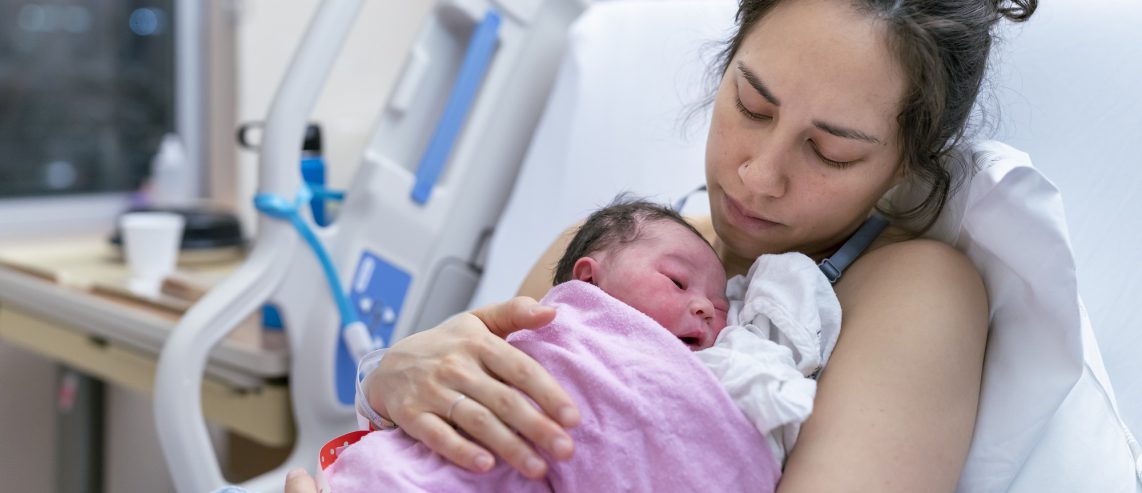Having a baby is joyful and rewarding, but a vaginal delivery takes a toll on your body. In the days and weeks after your baby is born, it’s normal to feel exhausted, sore, and on an emotional rollercoaster. After the demands of pregnancy and birth, it’s essential to rest as much as possible and focus on recovery after vaginal delivery.
Every person’s birth experience differs, so everyone’s recovery process — and the time it takes to recover — can also vary. But understanding what happens to your body during birth helps you care for yourself weeks after delivery. That’s important for you, your baby, and the rest of your family.
Never Miss a Beat!
Subscribe to Our HealthBeat Newsletter!
Thank you for subscribing!
You can now select the specific newsletters you'd like to receive.
You are already subscribed.
Subscribe to more newsletters in our email preference center.
Sorry, an error occurred. Please try again later.
Get Healthy Tips Sent to Your Phone!
Physical Recovery After Vaginal Delivery
Giving birth is nothing short of a Herculean task. Pushing out a baby requires tremendous strength and stamina, so it’s no surprise it takes time for your body to bounce back. It usually takes at least six weeks but can take up to one year to physically recover and start to feel like your old self.
At your six-week postpartum visit, your healthcare provider will check you over. They will hopefully give you the OK to gradually resume your normal activities. In the meantime, take things slow to help your body heal and feel empowered to see a specialist if things still do not feel right.
Healing stitches after vaginal delivery
During delivery, you may have a vaginal tear (also called a perineal laceration). The perineum is the area between your vagina and the anus. The skin, muscle, and other tissues in this area stretch during delivery but can tear.
Vaginal tears are more likely to happen if:
- You have a vaginal delivery for the first time.
- Your baby’s head is larger than your vaginal opening.
- You deliver very quickly, and your vagina doesn’t have as much time to stretch and thin.
- You’re of Asian descent.
- Your doctor must use forceps or a vacuum to help your baby out.
- In a previous delivery, you had an episiotomy (your doctor made a surgical cut to widen your vaginal opening).
Some vaginal tears are minor and heal independently. Others are larger or penetrate deeper tissues like muscles around the vagina or rectum, requiring stitches.
In rare cases, your doctor may cut the tissue around the vagina and get your baby out quickly. This procedure is an episiotomy and also requires stitches. Decades ago, these were done routinely, but are not anymore.
You’ll probably have moderate pain, swelling, and discomfort from the tear or stitches in the first few days after giving birth. Your health care provider may recommend using an ice pack to reduce swelling and over-the-counter pain medicine as needed for pain.
These tips can help your stitches heal and reduce pain when you get home:
- Avoid wiping with toilet paper after you go to the bathroom. Instead, use a squirt bottle with warm water to clean the area and gently pat dry with a towel or baby wipe.
- Use a sitz bath several times a day. A sitz bath is a shallow bath that covers just your buttocks and genital area. It helps soothe your incision area.
- Use a pain-relieving spray with benzocaine or lidocaine. Ask your labor and delivery nurse for recommendations.
- If it’s hard or painful to have a bowel movement, ask your doctor about using a stool softener like MiraLAX®. You can buy these at the drugstore or ask your labor and delivery team for them after birth.
- Keep the area around your stitches dry and clean. You’ll be bleeding from the uterus, so change your sanitary pad every two to four hours.
- Avoid standing for long periods. If sitting on a chair or sofa is uncomfortable, try sitting on a pillow or lying on your side.
If you have stitches, you won’t need to have them removed — they’ll dissolve within a week or two. An episiotomy or significant tear takes about a month to heal completely. Still, most doctors recommend waiting at least six weeks before using a tampon, having sex, or doing any heavy lifting.
Your reproductive and pelvic organs
During pregnancy, your uterus is like a balloon, inflating little by little to accommodate your growing baby. By the end of your pregnancy, it’s the size of a watermelon and pushes your organs off to the side.
After birth, it takes about six weeks for your uterus to return to its pre-pregnancy size. Your other organs also need to move back to their normal orientation. During this time, you’ll likely experience the following:
- Mild menstrual-like cramping. This cramping is strongest in the first few days after birth and during breastfeeding. Your body releases hormones to help your uterus contract and shrink.
- Vaginal discharge called lochia. The blood and tissue lining your uterus while pregnant flow through the vagina. It’s bright red and like a heavy period right after delivery, but it will gradually fade and stop within a few weeks.
- Soreness in your vagina and perineum. Even if you don’t have a significant tear, pushing and stretching the skin may leave you sore and bruised. It can take several weeks for your perineum to heal.
- Hemorrhoids. These swollen veins develop from the pressure of pushing your baby out. Sitz baths can help hemorrhoids heal, and a stool softener can make bowel movements softer and easier to pass.
- Constipation. Hormone changes can make it harder to pass stool. Make sure you’re drinking at least eight glasses of water daily. And eat plenty of fruits, vegetables, and high-fiber whole grains like oatmeal or wheat bran to help get things moving.
- Incontinence. Pregnancy can weaken your pelvic floor muscles, leading to urine leakage when coughing or laughing. Pelvic floor exercises can help strengthen your pelvic floor muscles. “If this doesn’t improve, request a referral to a pelvic floor physical therapist or an evaluation
by a urogynecologist, which is a pelvic floor specialist for female patients. UPMC Magee-Womens Hospital also has a special Postpartum Pelvic Floor Healing Clinic for postpartum pelvic floor injury, also known as the MOMMA Clinic, that can do a full evaluation of your pelvic floor function,” says Jocelyn Fitzgerald, MD, a urogynecologist at the UPMC Magee-Womens Center for Bladder and Pelvic Health.
Mental Health Recovery After Giving Birth
Giving birth is not only a physical experience. It’s also very emotional and intensified by sudden changes in your hormones. Taking care of your mental health days and weeks after delivery is also an important part of recovery.
Sudden hormonal changes, a lack of sleep, and the stark reality of having a newborn can trigger the “baby blues.” You might feel sad or weepy for a few days after giving birth. Other symptoms of baby blues might include:
- Feeling anxious or overwhelmed.
- Having mood swings.
- Having frequent crying spells.
- Losing your appetite.
- Having trouble sleeping.
Baby blues are common and usually last just a few days. Contact your doctor if you’re feeling sad, empty, or hopeless for longer than two weeks. About one in nine women develop more serious emotional changes known as postpartum depression or anxiety.
Signs of postpartum depression include:
- Feeling sad or hopeless.
- Having little energy or motivation.
- Having trouble remembering things or making decisions.
- Feeling like a bad parent.
- Not having any interest in your baby.
- Having thoughts of hurting yourself or your baby.
- Excessive worrying and intrusive thoughts.
- Disrupted sleep, from waking up worried about your baby.
- Heart palpitations from anxiety.
- Feeling afraid that something terrible will happen to your baby.
Postpartum depression or anxiety often starts within the first month after delivery, but it can happen anytime within the first year. Symptoms are more severe and much longer lasting than the baby blues. Talk to your doctor about these symptoms because therapy and medicine can help you feel better.
As a new parent, you have a lot on your plate. Taking time to recover after vaginal delivery is crucial to give you and your baby the best start possible. Call your health care provider if you have questions or concerns about anything during your recovery.
Editor's Note: This article was originally published on , and was last reviewed on .
Sources
About UPMC Magee-Womens
Built upon our flagship, UPMC Magee-Womens Hospital in Pittsburgh, and its century-plus history of providing high-quality medical care for people at all stages of life, UPMC Magee-Womens is nationally renowned for its outstanding care for women and their families.
Our Magee-Womens network – from women’s imaging centers and specialty care to outpatient and hospital-based services – provides care throughout Pennsylvania, so the help you need is always close to home. More than 25,000 babies are born at our network hospitals each year, with 10,000 of those babies born at UPMC Magee in Pittsburgh, home to one of the largest NICUs in the country. The Department of Health and Human Services recognizes Magee in Pittsburgh as a National Center of Excellence in Women’s Health; U.S. News & World Report ranks Magee nationally in gynecology. The Magee-Womens Research Institute was the first and is the largest research institute in the U.S. devoted exclusively to women’s health and reproductive biology, with locations in Pittsburgh and Erie.

